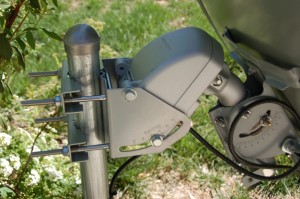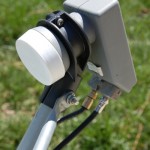After I had my satellite pole properly set, it was time to aim the dish. While I had little trouble finding a satellite earlier when I simply stuck the dish on the pole and fiddled a bit, I found it much more difficult to make things work when I added the mount motor. That’s because the motor adds its own angle to the mix, so you have two dials to set, not just one. When you couple that with an instruction manual often written with poor English it becomes an even greater challenge.
I mounted the motor to the pole, attached the dish to it, and began fiddling. And fiddling. And fiddling some more. I just couldn’t get the receiver to work. The motor needed to be pointed directly south and I worked a long time to get it correct. It didn’t help that I had my TV and receiver all the way inside while I worked. Though I had a “satellite beeper” device which makes a tone when it detects a satellite, I couldn’t get the receiver to do what I wanted.
After putting in a few hours over a few nights, working on the aiming, I finally thought to move the receiver closer to the dish while I was adjusting it. I didn’t have a portable TV so I actually used the DVD player built into the minivan! Once I had more direct feedback with my aiming (and also learned that I was operating the receiver all wrong), I soon locked on to a few satellites. Further adjustment gave me all the satellites I could reach! Some satellites are too low in the sky to clear the trees, but everything else came in as expected. Boy, was I happy!
One of the things I found to be most exciting about this whole setup is the motor. When I first started working with the DVB stuff I did it with static dishes: always pointed to the same satellites. I thought the way to get more satellites was to get more dishes. Then I discovered these motor mounts, which can point one dish to multiple satellites. Suddenly, tuning in the world of FTA satellites becomes much more affordable! There was only one problem for me: my receiver wasn’t properly moving the dish!
It turns out that I was using the wrong motor settings in my receiver. There are a few command standards for motor mounts: DisEqC 1.2 and USALS. DisEqC 1.2 is a bit more delicate than USALS. All USALS requires to work is to input your latitude and longitude and it does the rest. Only when I had the receiver using USALS did the dish start finding the satellites.
And what did I find up there? A whole world of free programming! Many of the channels are foreign government channels. Several are in foreign languages. Some are downright bizarre. And others are quite interesting.
When Hosni Mubarak stepped down in Egypt, I watched it live on Al Jazeera. I’ve found Al Jazeera to be a pretty fair and scrappy news organization. I’ve since watched it as events in Libya unfold.
When the earthquake, tsunami, and nuclear accident devastated Japan, I watched NTK (Japan’s government news channel) right off the satellite. It’s pretty exciting to get this news directly from the source.
Then there are the wildfeeds. Many sporting events can be watched straight from the signal beamed up from the arena. I’ve enjoyed watching hockey games, baseball games, basketball games, auto racing, and other sporting events. There’s also the occasional news feed, product announcement feed, and other random stuff. You never know what kind of goodies you’ll find.
How do you find them? Visit the many FTA message boards out there, where other dish owners post what they’ve discovered. Or, you can get a receiver that does a “blind scan” and searches the satellites for all available channels.
Another consideration is the resolution of your receiver. With HD being the new television standard, the older SD-only receivers aren’t able to view the HD signals. There are still plenty of SD feeds around but the growing number of HD feeds makes an HD receiver a must-have.
I’ve learned a ton about FTA satellite in the past few weeks and still have lots to learn. The biggest thing I’ve learned is that it’s not impossible to get into this. In many ways, it’s actually easier than I thought. Feel free to hit me up for further information if any of you would like to find out more. I’m happy to show you the way.



I’d love to actually see your setup sometime. I’m curious as to how long it takes the motor to move to each satellite and what that does to how long it takes to actually see a channel from when you select it. Also, how would this all connect to MythTV (if possible)?
It takes a few seconds for the dish to position itself, so I sort my channels by their orbital position so that the time is minimized between channels.
My older DVB PCI card is not able to drive the dish itself, so that’s why I use a dual LNB. I let my newer satellite receiver drive the dish and feed the extra signal from the LNB to my DVB card, where MythTV can see it.
I understand Myth can drive these dishes by itself but I assume it needs a satellite card that understands something other than the base DisEQC 1.0 standard.
The higher-resolution video seems to get corrupted when the DVB card captures it. I don’t know if its a driver issue or what. That image I posted of Roy was one good shot out of a sea of dropped MPEG frames. I’m beginning to wonder if my years-old DVB card just isn’t up to the task of capturing HD transport streams, but I’m still tinkering and haven’t confirmed much yet!
Myth doesn’t deal well with wildfeeds at this point. The only way to tell Myth to tune something in is through a schedule provider like SchedulesDirect. If someone could write an interface that could take a Tweet and automatically tune Myth using that info, that would be sweet! A project for another day, though…
Awesome job, Mark! Your set-up looks great – glad to see everything is working out well for you.
Thanks for all your help, Chuck!
My Openbox S9 arrives this weekend! Look for a review here soon. 🙂